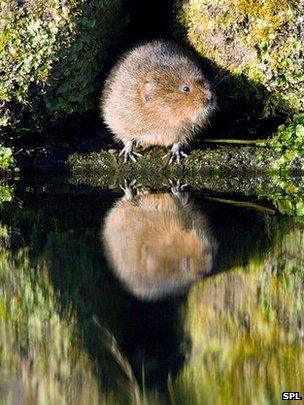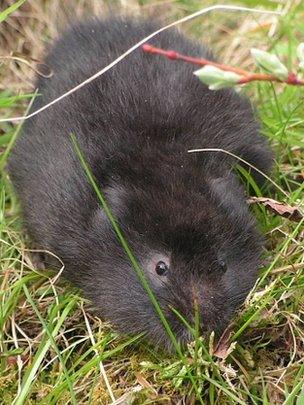Water voles wander across 'fragmented' Scottish habitat
- Published

Voles' survival strategies hint at what to expect in increasingly fragmented natural habitats
Scottish water voles have been found to travel enormous distances, enabling them to persist in fragmented habitats.
The large rodents travel around bogs, lochs and moors in order to join, or establish, new colonies.
Although the findings were based on a species adapted to a "patchy" environment, the work could help biologists understand how habitat fragmentation may affect other animals.
The research was presented at the British Science Festival, external in Aberdeen.
Water voles living in the north-west of Scotland live in small family groups of five to 10 individuals separated from other small populations by kilometres.
By studying the behaviour of the mammals, Prof Xavier Lambin and his colleagues from the University of Aberdeen discovered that far from remaining isolated, young members of the family groups wandered huge distances away from their "home" territory.
"We were astounded," Prof Lambin told the BBC.
"Those animals typically have a home range of a few hundred square meters, and we found them moving two to three kilometres, a few even moving 15 kilometres between [the site of] their birth and their first reproduction."
The vast journeys are extremely hazardous for the voles, during which they are exposed to predation away from the safety of their burrows.
Moving out
The dispersal strategy appears to be very effective in allowing the voles to thrive in such small numbers and at such great distances from each other.
Individuals arrive at a "patch", wait five or six days to see if a potential mate arrives, and then move on if no other voles appear.
"They will hit the road, and again face predators and take the chance, and hopefully find another patch. They can do this for seven weeks - if they're lucky," Prof Lambin said.

He told the BBC how he and his team employed a citizen science team of interested members of the public as well as members of the university to help monitor individuals and whether they were present in appropriate habitats.
"For the last 13 years, we've had a team of volunteers that roam the hills for six weeks a year, students and researchers. We visit all the patches that has habitat that would be suitable... Then we use capture-marking-recapture techniques with a little e-tag, and we also take a small piece of tissue from which we can extract DNA, so we can reconstruct the dispersal behaviour," he said.
The results from the work indicate the ability to travel large distances, creating links in a network of colonies, enables the mammals to persist at very low densities in the hills of north-west Scotland.
Fragmentation risk
The researchers also concluded that the movement of voles from one patch of habitat to another spread diseases or pathogens to the newly explored areas.
But it also led to populations in danger of "crashing" being rescued by colonising individuals.
"It's actually this movement of individuals moving and colonising patches that lets these populations persist for long periods of time," said doctoral student Chris Sutherland who co-presented the research.
"It's a balancing act of the colonisation process when they move huge distances compensating for the fact that, because these populations are naturally small, they're more likely to go extinct," he said.
Although the water voles have evolved this behaviour in a naturally fragmented habitat, the research team hope their work will allow them to understand how important movement across corridors and between patches is for the survival of other species that find themselves in an increasingly fragmented world.
"Humans keep chopping up big pieces of landscape into smaller and smaller patches. And the ability of species to persist in those fragmented landscapes really requires them to be able to disperse and find each other," Prof Lambin said.
Professor Lambin and Chris Sutherland appear on the special British Science Festival edition of Material World broadcast on Thursday 6 September and will be available on the iPlayer.
- Published5 September 2012
- Published6 September 2012